Ciaran Dunne’s interest in model making comes from his own farming background. The Dunne farm near Thurles, Co Tipperary, consists of both dairy and beef enterprises. Ciaran had the usual assortment of farm models when growing up – toy tractors and machinery that most young children typically would have.
Often the shops wouldn’t have a model Ciaran wanted, so he decided to start building them himself. He further developed these skills as he got older and ultimately deciding on model making as a career.
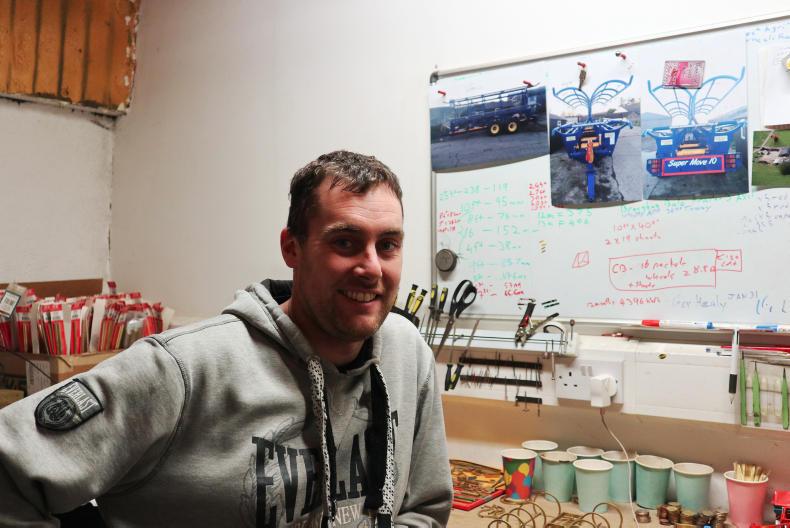
Ciaran Dunne has turned his childhood hobby into a successful business.
After secondary school, Ciaran went to England to attend the Arts University College Bournemouth (AUCB). There, Ciaran spent three years doing a BA (Hons) model-making course with the ultimate goal of landing a job making architectural models.
In his final year, things took an agricultural turn. After plans to build a model of the Burj Khalifa, (Dubai’s tallest building) for his final year project fell through, Ciaran went back to the drawing board.
Having come across a model of a hedge cutter, he realised could build a much more detailed version. Hedge cutters are not common models due to the complexity of their design, especially if moving functionality is to be achieved. So Ciaran took this opportunity and produced a brass-built McConnell hedgecutter in 1:32 scale for his final-year project. This is where he honed and developed his skills, producing incredibly precise and detailed models.
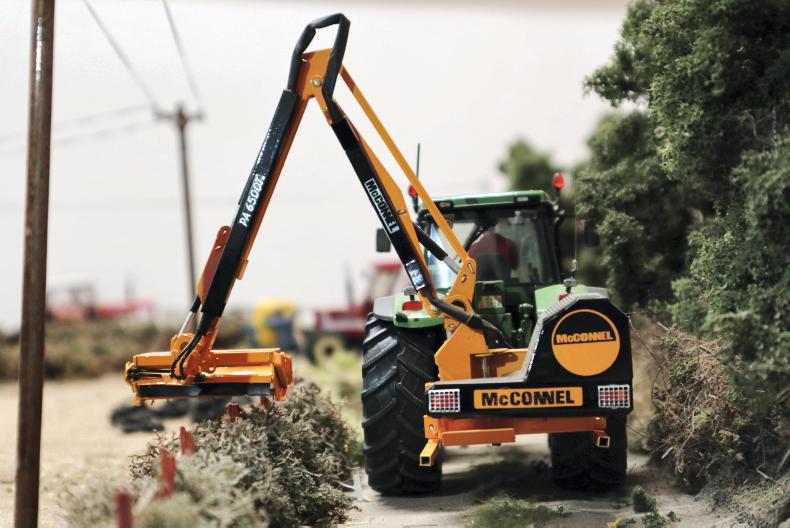
The McConnell PA6500T. These particular models played a huge part in Ciaran's success.
Ciaran explained what he learned in college: “It showed me how to make pretty much anything out of anything, from plastic, metal, resin and fiberglass. On the computing side, there is 3D modelling, special effects for filming and also prototype building.”
Ciaran enjoys driving occasionally for local contractors in the summer season. This allows him to see machinery from a new perspective, leaving him with a fresh mind when back in the workshop, model building.
The beginning of Perfect 32
Ciaran started off in his family home making models of McHale bale handlers, OCE folding grass forks along with shear grabs. To date, the McHale bale handlers are the top-selling product, and take shy of two hours to build from start to finish.
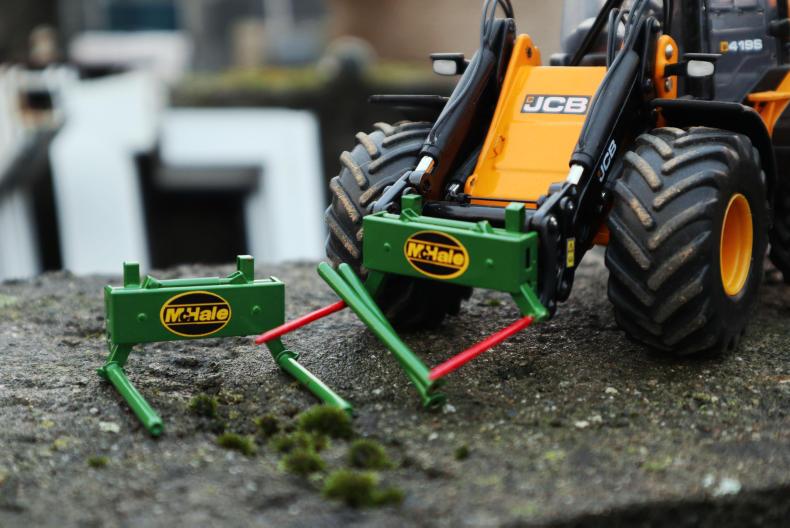
The McHale bale hander is one of Ciaran's best sellers to date.
When the business, called Perfect 32, started expanding, he moved out to a workshop on the farm which he set up for the job. His tool-filled workshop feels like a man cave for a model or machinery enthusiast. The brass-laden counters catch the eye as almost all the models are made from some shape or form of brass.
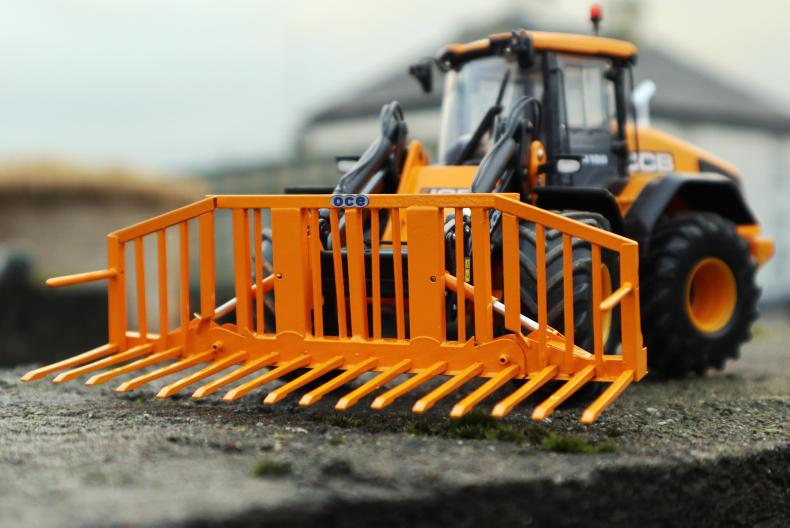
The folding OCE grass forks were among Ciaran's first popular models.
Ciaran’s workshop contains all the tools and materials he would ever need. There are shelves stocked with lengths of brass ranging in shape and thickness, band saws, pillar drills, belt sanders, metal bending tools.

All parts are cut and bent individually, then solder is applied using a gas torch.
Moving out the back, he has a ventilated spray booth, where he preps and sprays each individual part with the exact paint of each machine’s manufacturer. They are then hung to dry in the warm workshop on a line.

Ciaran's purpose-built workshop.
The making of the models
Once drawings have been sourced from the manufacturer for a particular product, they are scaled back to 1:32. Ciaran then draws out all the components needed for assembly on the computer. The drawings are then sent to the UK to be laser-cut and acid-etched from sheet brass.
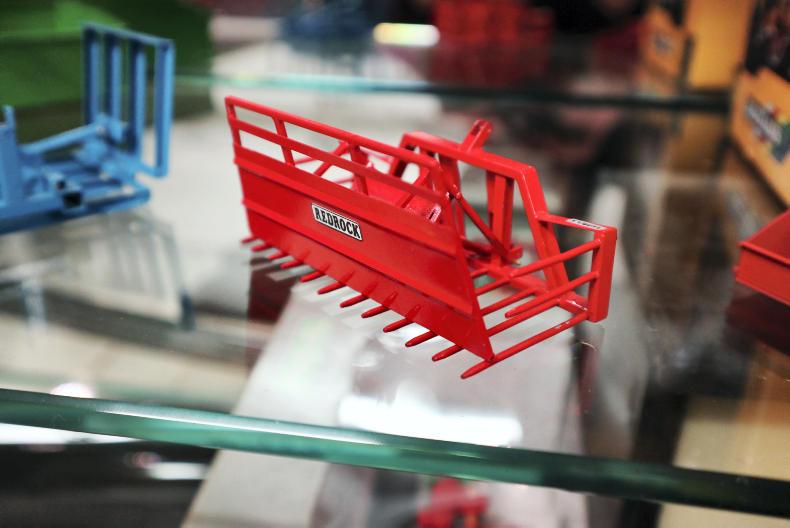
Redrock push off buckrake.
Once returned, Ciaran folds and solders together the intricate parts step by step, building multiple models at once. This idea of batch production speeds up the process. Once assembled, the individual parts are then unassembled and go for painting. Some parts may require 3D printing. This is done by a company in Dublin. Once painted and reassembled, the models are ready for stickers, giving them the finishing touch. All stickers are made locally by a woman who happens to have the right machine for the job.
Ciaran makes most of his models to order or limits production to a set number.
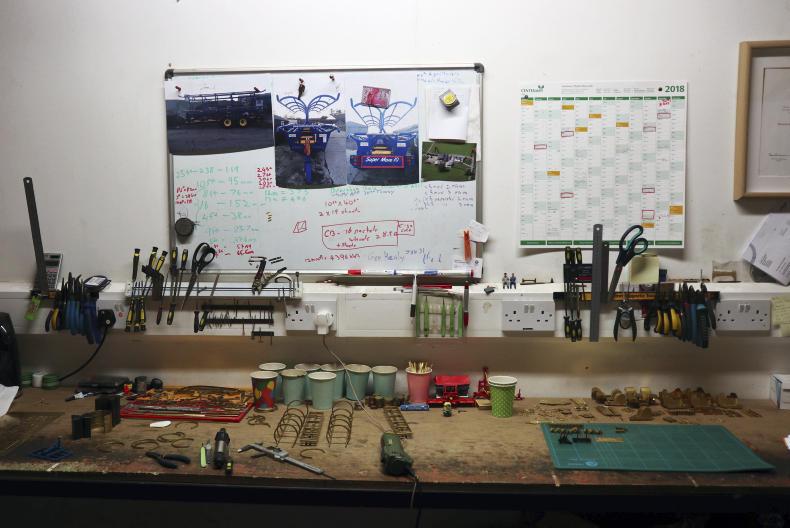
Where the magic happens and endless hours are put in.
McConnell hedge cutter
Upon completing his degree in 2010, Ciaran decided to drop a model of his PA6500T hedge cutter into a local McConnell dealer. McConnell later saw the model and approached him. Ciaran made a few small changes and McConnell then placed an order for 100 models, with models later ending up on show at Agritechnica.
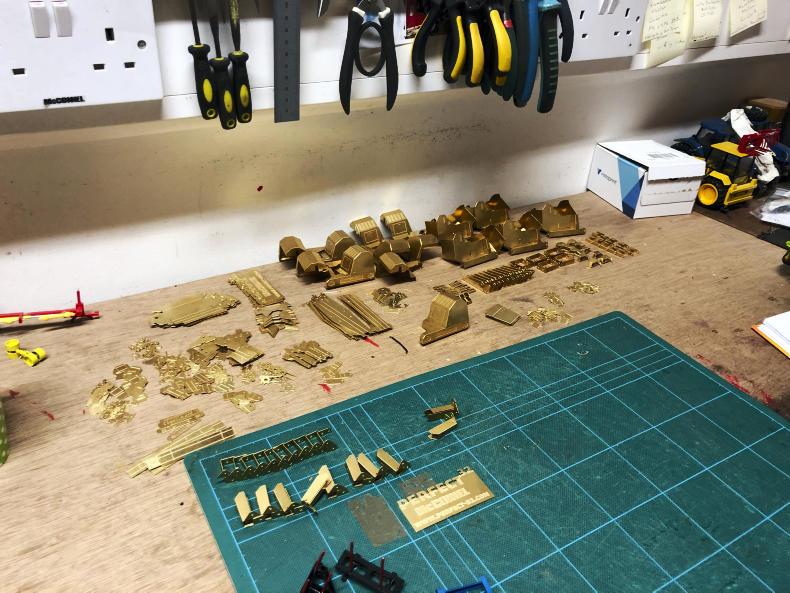
Spread out are most of the components to build 15 hedgecutters
So Ciaran got to work, calling in help of a few friends and started building each individual hedge cutter. Each model requires a total of 15 hours to build.
After viewing a finished model, it’s easy to see where all the production hours went, from the swivel heads to small intricate parts, rotor detail, telescopic arm movement right through to the proper movement of all linkages, just as if it was the real machine. The completed PA6500T fetches a price of €320, which is fair considering the time and effort that goes into the building of the model. This is the model that really got Ciaran better known in the business.
Current projects
When we caught up with Ciaran, he was working on a number of Wilson Super Move 10-bale transporters. These bale transporters took four days to design and 20 hours each to build.
Each transporter contains roughly 28ft of brass and sells for €450.
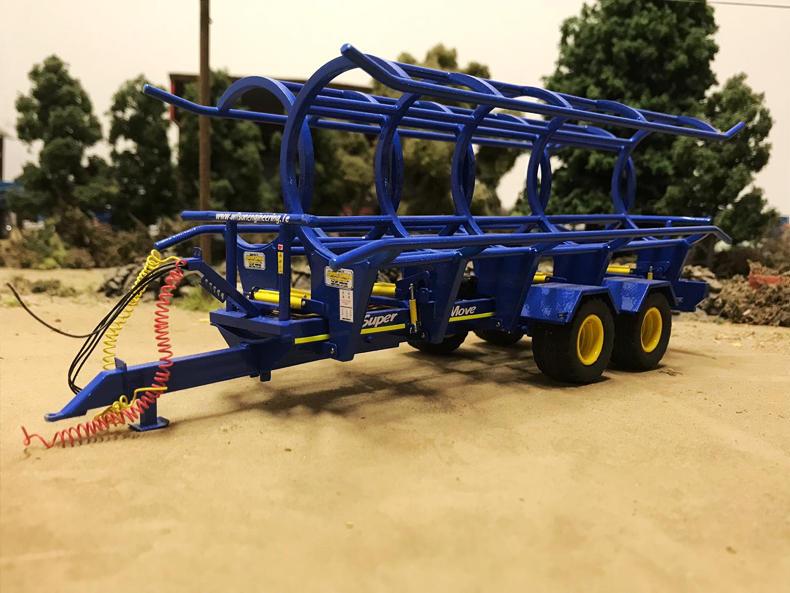
Wilson Super Move 10 bale trailer
Ciaran produced 20 limited edition Armer Salmon Cheetah single-row beet harvesters, two weathered versions and one prototype model, after one month in the design process. Each take 48 hours to build. Parts are produced from acid etching, CNC laser cutting and 3D printing.
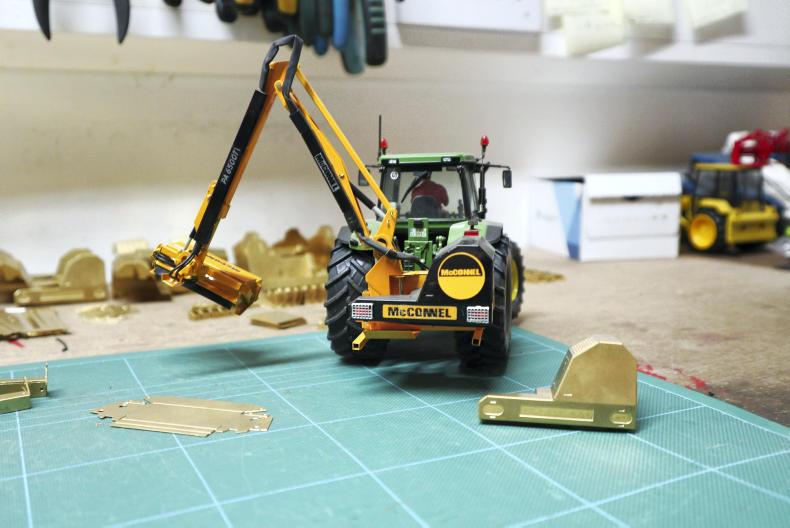
McConnell PA6500T surrounded by all its brass components
Every beet harvester sold comes with a plaque stating its production number. One of these models is rumoured to have recently been sold on an online auction site, fetching double what was paid for it new.
Following this, Ciaran wanted to make 30 limited twin-row Armer Salmon Beaver beet harvesters. This was one of the most detailed models made to date, according to Ciaran, with 20 made so far. Early 2019 sees plans for manufacture of the remaining 10, with all sold already apart from two and priced at €1,300 each.
Model modifications
Another part of Ciaran’s business is model modifications. This is where collectors will leave models with him to be modified, often to make them look more realistic. These modifications include respraying, adding of stickers, lights, number plates and new wheels.
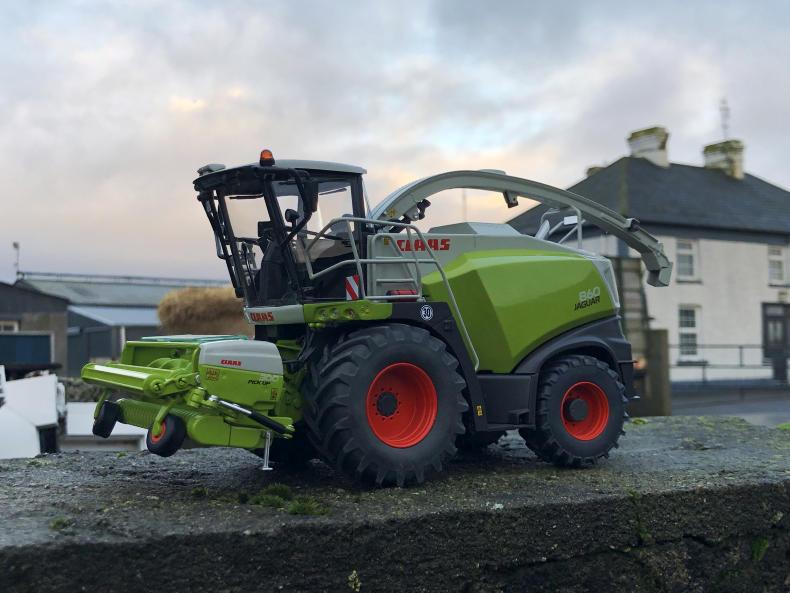
Claas Jaguar 860 in for wider tyres, number plates and extra stickers
Recently, Ciaran had a Claas Arion tractor in for modifications which included bonnet and chassis shortening, to suit the dimensions of the real four-cylinder variant. Ciaran had a Claas Jaguar forage harvester in for wider wheels and number plates, while I was there.
From talking to him, you’d know straight away he loves what he does. “I feel I have turned an old hobby into a job that I now love and also incorporates my passion for machinery.”
Ciaran plans to keep building models with the hope to get his models more and more detailed. He will continue to focus on quality and detail rather than on big production numbers. Ciaran’s work will be on show next at the Carrickdale Model Toy Show on 24 February in the Carrickdale Hotel, Dundalk, Co Louth.
WIN a model tractor and two tickets to the FTMTA Farm Machinery Show
Answer the questions below correctly to be in with a chance of winning one of three 1:32 scale model tractors sponsored by Tinney Toys along with two tickets to the FTMTA Farm Machinery Show in Punchestown in February 2019. Entries close 15 January.
Ciaran Dunne’s interest in model making comes from his own farming background. The Dunne farm near Thurles, Co Tipperary, consists of both dairy and beef enterprises. Ciaran had the usual assortment of farm models when growing up – toy tractors and machinery that most young children typically would have.
Often the shops wouldn’t have a model Ciaran wanted, so he decided to start building them himself. He further developed these skills as he got older and ultimately deciding on model making as a career.

Ciaran Dunne has turned his childhood hobby into a successful business.
After secondary school, Ciaran went to England to attend the Arts University College Bournemouth (AUCB). There, Ciaran spent three years doing a BA (Hons) model-making course with the ultimate goal of landing a job making architectural models.
In his final year, things took an agricultural turn. After plans to build a model of the Burj Khalifa, (Dubai’s tallest building) for his final year project fell through, Ciaran went back to the drawing board.
Having come across a model of a hedge cutter, he realised could build a much more detailed version. Hedge cutters are not common models due to the complexity of their design, especially if moving functionality is to be achieved. So Ciaran took this opportunity and produced a brass-built McConnell hedgecutter in 1:32 scale for his final-year project. This is where he honed and developed his skills, producing incredibly precise and detailed models.

The McConnell PA6500T. These particular models played a huge part in Ciaran's success.
Ciaran explained what he learned in college: “It showed me how to make pretty much anything out of anything, from plastic, metal, resin and fiberglass. On the computing side, there is 3D modelling, special effects for filming and also prototype building.”
Ciaran enjoys driving occasionally for local contractors in the summer season. This allows him to see machinery from a new perspective, leaving him with a fresh mind when back in the workshop, model building.
The beginning of Perfect 32
Ciaran started off in his family home making models of McHale bale handlers, OCE folding grass forks along with shear grabs. To date, the McHale bale handlers are the top-selling product, and take shy of two hours to build from start to finish.

The McHale bale hander is one of Ciaran's best sellers to date.
When the business, called Perfect 32, started expanding, he moved out to a workshop on the farm which he set up for the job. His tool-filled workshop feels like a man cave for a model or machinery enthusiast. The brass-laden counters catch the eye as almost all the models are made from some shape or form of brass.

The folding OCE grass forks were among Ciaran's first popular models.
Ciaran’s workshop contains all the tools and materials he would ever need. There are shelves stocked with lengths of brass ranging in shape and thickness, band saws, pillar drills, belt sanders, metal bending tools.

All parts are cut and bent individually, then solder is applied using a gas torch.
Moving out the back, he has a ventilated spray booth, where he preps and sprays each individual part with the exact paint of each machine’s manufacturer. They are then hung to dry in the warm workshop on a line.

Ciaran's purpose-built workshop.
The making of the models
Once drawings have been sourced from the manufacturer for a particular product, they are scaled back to 1:32. Ciaran then draws out all the components needed for assembly on the computer. The drawings are then sent to the UK to be laser-cut and acid-etched from sheet brass.

Redrock push off buckrake.
Once returned, Ciaran folds and solders together the intricate parts step by step, building multiple models at once. This idea of batch production speeds up the process. Once assembled, the individual parts are then unassembled and go for painting. Some parts may require 3D printing. This is done by a company in Dublin. Once painted and reassembled, the models are ready for stickers, giving them the finishing touch. All stickers are made locally by a woman who happens to have the right machine for the job.
Ciaran makes most of his models to order or limits production to a set number.

Where the magic happens and endless hours are put in.
McConnell hedge cutter
Upon completing his degree in 2010, Ciaran decided to drop a model of his PA6500T hedge cutter into a local McConnell dealer. McConnell later saw the model and approached him. Ciaran made a few small changes and McConnell then placed an order for 100 models, with models later ending up on show at Agritechnica.

Spread out are most of the components to build 15 hedgecutters
So Ciaran got to work, calling in help of a few friends and started building each individual hedge cutter. Each model requires a total of 15 hours to build.
After viewing a finished model, it’s easy to see where all the production hours went, from the swivel heads to small intricate parts, rotor detail, telescopic arm movement right through to the proper movement of all linkages, just as if it was the real machine. The completed PA6500T fetches a price of €320, which is fair considering the time and effort that goes into the building of the model. This is the model that really got Ciaran better known in the business.
Current projects
When we caught up with Ciaran, he was working on a number of Wilson Super Move 10-bale transporters. These bale transporters took four days to design and 20 hours each to build.
Each transporter contains roughly 28ft of brass and sells for €450.

Wilson Super Move 10 bale trailer
Ciaran produced 20 limited edition Armer Salmon Cheetah single-row beet harvesters, two weathered versions and one prototype model, after one month in the design process. Each take 48 hours to build. Parts are produced from acid etching, CNC laser cutting and 3D printing.

McConnell PA6500T surrounded by all its brass components
Every beet harvester sold comes with a plaque stating its production number. One of these models is rumoured to have recently been sold on an online auction site, fetching double what was paid for it new.
Following this, Ciaran wanted to make 30 limited twin-row Armer Salmon Beaver beet harvesters. This was one of the most detailed models made to date, according to Ciaran, with 20 made so far. Early 2019 sees plans for manufacture of the remaining 10, with all sold already apart from two and priced at €1,300 each.
Model modifications
Another part of Ciaran’s business is model modifications. This is where collectors will leave models with him to be modified, often to make them look more realistic. These modifications include respraying, adding of stickers, lights, number plates and new wheels.

Claas Jaguar 860 in for wider tyres, number plates and extra stickers
Recently, Ciaran had a Claas Arion tractor in for modifications which included bonnet and chassis shortening, to suit the dimensions of the real four-cylinder variant. Ciaran had a Claas Jaguar forage harvester in for wider wheels and number plates, while I was there.
From talking to him, you’d know straight away he loves what he does. “I feel I have turned an old hobby into a job that I now love and also incorporates my passion for machinery.”
Ciaran plans to keep building models with the hope to get his models more and more detailed. He will continue to focus on quality and detail rather than on big production numbers. Ciaran’s work will be on show next at the Carrickdale Model Toy Show on 24 February in the Carrickdale Hotel, Dundalk, Co Louth.
WIN a model tractor and two tickets to the FTMTA Farm Machinery Show
Answer the questions below correctly to be in with a chance of winning one of three 1:32 scale model tractors sponsored by Tinney Toys along with two tickets to the FTMTA Farm Machinery Show in Punchestown in February 2019. Entries close 15 January.


















 This is a subscriber-only article
This is a subscriber-only article







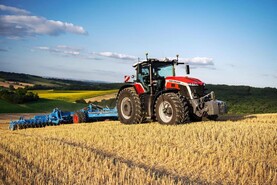
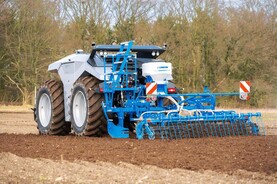


SHARING OPTIONS: